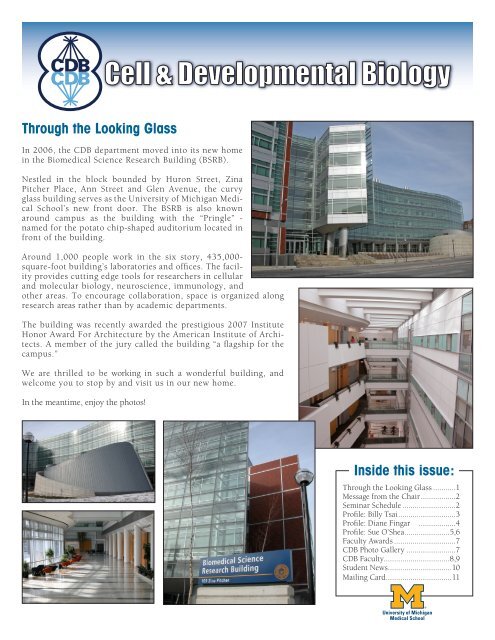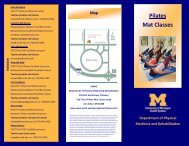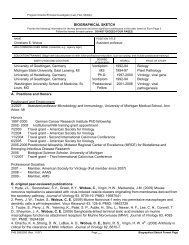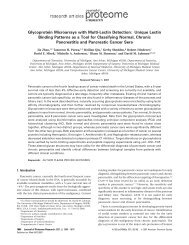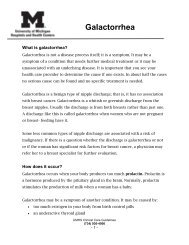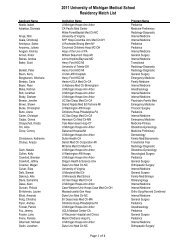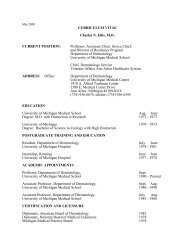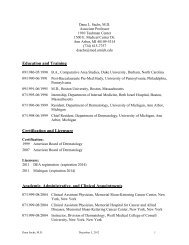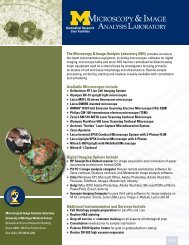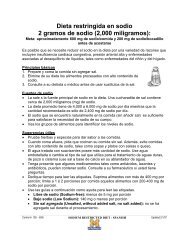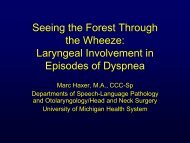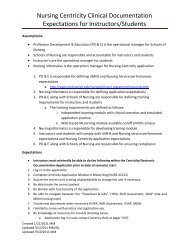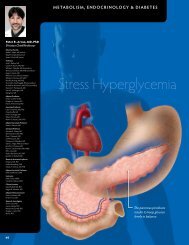Inside this issue: Through the Looking Glass - University of Michigan ...
Inside this issue: Through the Looking Glass - University of Michigan ...
Inside this issue: Through the Looking Glass - University of Michigan ...
You also want an ePaper? Increase the reach of your titles
YUMPU automatically turns print PDFs into web optimized ePapers that Google loves.
<strong>Through</strong> <strong>the</strong> <strong>Looking</strong> <strong>Glass</strong><br />
In 2006, <strong>the</strong> CDB department moved into its new home<br />
in <strong>the</strong> Biomedical Science Research Building (BSRB).<br />
Nestled in <strong>the</strong> block bounded by Huron Street, Zina<br />
Pitcher Place, Ann Street and Glen Avenue, <strong>the</strong> curvy<br />
glass building serves as <strong>the</strong> <strong>University</strong> <strong>of</strong> <strong>Michigan</strong> Medical<br />
School’s new front door. The BSRB is also known<br />
around campus as <strong>the</strong> building with <strong>the</strong> “Pringle” -<br />
named for <strong>the</strong> potato chip-shaped auditorium located in<br />
front <strong>of</strong> <strong>the</strong> building.<br />
Around 1,000 people work in <strong>the</strong> six story, 435,000square-foot<br />
building’s laboratories and <strong>of</strong>fices. The facility<br />
provides cutting edge tools for researchers in cellular<br />
and molecular biology, neuroscience, immunology, and<br />
o<strong>the</strong>r areas. To encourage collaboration, space is organized along<br />
research areas ra<strong>the</strong>r than by academic departments.<br />
The building was recently awarded <strong>the</strong> prestigious 2007 Institute<br />
Honor Award For Architecture by <strong>the</strong> American Institute <strong>of</strong> Architects.<br />
A member <strong>of</strong> <strong>the</strong> jury called <strong>the</strong> building “a flagship for <strong>the</strong><br />
campus.”<br />
We are thrilled to be working in such a wonderful building, and<br />
welcome you to stop by and visit us in our new home.<br />
In <strong>the</strong> meantime, enjoy <strong>the</strong> photos!<br />
<strong>Inside</strong> <strong>this</strong> <strong>issue</strong>:<br />
<strong>Through</strong> <strong>the</strong> <strong>Looking</strong> <strong>Glass</strong> ...........1<br />
Message from <strong>the</strong> Chair .................2<br />
Seminar Schedule ..........................2<br />
Pr<strong>of</strong>ile: Billy Tsai ............................3<br />
Pr<strong>of</strong>ile: Diane Fingar ..................4<br />
Pr<strong>of</strong>ile: Sue O’Shea ......................5,6<br />
Faculty Awards ..............................7<br />
CDB Photo Gallery ........................7<br />
CDB Faculty ................................8,9<br />
Student News ...............................10<br />
Mailing Card ................................11
2<br />
As you can see by <strong>the</strong> pictures<br />
on <strong>the</strong> cover, we have moved<br />
and now live in a beautiful, lightfilled,<br />
open facility. The BSRB<br />
was designed to foster collaborative<br />
interactions, and <strong>the</strong> building<br />
design has more than fulfilled<br />
that purpose. We collaborate<br />
with o<strong>the</strong>r investigators located<br />
nearby and share equipment, facilities<br />
and (most importantly)<br />
ideas throughout <strong>the</strong> building:<br />
we feel fortunate to have been<br />
chosen to be among <strong>the</strong> first BSRB<br />
tenants. The entire Department has now moved, including<br />
<strong>the</strong> Center for Organogenesis, <strong>the</strong> Human Embryonic Stem<br />
Cell Core Laboratory, and <strong>the</strong> Microscopy and Image Analysis<br />
Laboratory.<br />
We have recruited ten extremely talented new faculty to <strong>the</strong><br />
Department over <strong>the</strong> past four years, and are currently in <strong>the</strong><br />
process <strong>of</strong> recruiting new senior faculty. Our graduate student<br />
program has increased proportionally during <strong>this</strong> time,<br />
and we are very proud <strong>of</strong> <strong>the</strong> accomplishments <strong>of</strong> our faculty<br />
(new and not so new), postdocs and students, some <strong>of</strong> which<br />
are highlighted in <strong>this</strong> newsletter. In addition to new personnel,<br />
we have expanded programs and services throughout<br />
<strong>the</strong> Department.<br />
The Center for Organogenesis continues to provide an intellectual<br />
focal point within <strong>the</strong> Department, and recently<br />
established a Bio-Artography program which generates interesting<br />
scientific images in a printed and framed art format.<br />
The proceeds from bioartography are used entirely for support<br />
<strong>of</strong> our graduate programs. This CFO program began<br />
with a booth at <strong>the</strong> Ann Arbor Art Fair and has grown to include<br />
a website http://bioartography.com/ so that interested<br />
people can view and purchase <strong>the</strong> art. We will feature more<br />
Organogenesis progress and vision in future newsletters.<br />
The Microscopy and Image Analysis Laboratory (MIAL) is a<br />
state-<strong>of</strong>-<strong>the</strong>-art centralized facility housing microscopes and<br />
o<strong>the</strong>r equipment that is used on a shared basis by investigators<br />
throughout <strong>the</strong> <strong>University</strong>. It is a fee-for-service-based<br />
facility open to all researchers (approximately 325 investigators<br />
are included among <strong>the</strong> MIAL’s 1,000 users). This facility<br />
<strong>of</strong>fers help and instruction in <strong>the</strong> use <strong>of</strong> three confocal<br />
microscopes, three wide field fluorescent microscopes, TEM<br />
and SEM as well as a host <strong>of</strong> image analysis s<strong>of</strong>tware. The<br />
MIAL recently purchased a Deltavision RT Image Restoration<br />
System for live cell imaging, keeping <strong>this</strong> core facility at<br />
<strong>the</strong> technological cutting edge. We will feature more <strong>of</strong> <strong>the</strong><br />
MIAL’s services and equipment in future newsletters.<br />
Message from <strong>the</strong> Chair<br />
Cell & Developmental Biology • Spring 2007<br />
The Department has set aggressive and yet hopefully realistic<br />
goals for expansion <strong>of</strong> our base <strong>of</strong> academic excellence:<br />
we continue to seek additional funding for expansion <strong>of</strong> <strong>the</strong><br />
Human Embryonic Stem Cell Core facilities as well as to establish<br />
<strong>the</strong> Center for Organogenesis as <strong>the</strong> first <strong>of</strong> its kind<br />
NIH-funded Center. Efforts will also continue to add cutting<br />
edge microscopy tools to <strong>the</strong> MIAL, and expand virtual microscopy<br />
teaching techniques for Medical Histology.<br />
I hope you enjoy <strong>this</strong> newsletter – <strong>the</strong> first <strong>of</strong> many to come.<br />
We look forward to hearing from you and want to know<br />
about your current position and achievements. And please,<br />
do feel free to come and visit us in our new home!<br />
James Douglas Engel, Ph.D.<br />
Chair<br />
Cell and Developmental Biology<br />
G. Carl Huber Pr<strong>of</strong>essor <strong>of</strong> Developmental Biology<br />
CDB Seminars:<br />
5/16/07 Bob Lamb<br />
Pr<strong>of</strong>essor, Northwestern <strong>University</strong><br />
Co-host with Microbiology<br />
12pm-1pm, Seminar A,B & C BSRB<br />
9/12/07 John F. Fallon<br />
Pr<strong>of</strong>essor, <strong>University</strong> <strong>of</strong> Wisconsin-Madison<br />
12pm-1pm, Seminar A,B & C BSRB<br />
10/10/07 Ken Zaret<br />
Pr<strong>of</strong>essor - Fox Chase Cancer Center<br />
11/14/07 David Russell<br />
Pr<strong>of</strong>essor, UT Southwestern<br />
12/12/07 Cliff Tabin<br />
Pr<strong>of</strong>essor, Harvard Medical School
Cell & Developmental Biology • Spring 2007<br />
Billy was named a <strong>University</strong> <strong>of</strong> <strong>Michigan</strong> Biological Sciences<br />
Scholar and joined <strong>the</strong> CDB faculty as an Assistant Pr<strong>of</strong>essor<br />
in September 2003. Since <strong>the</strong>n he has become a Burroughs<br />
Wellcome Fund Fellow and received funding for his research<br />
program from NIH.<br />
Education:<br />
B.S., UCLA, 1989-1993<br />
(magna cum laude and Phi Beta Kappa)<br />
M.S., UCLA, 1993-1994<br />
Ph.D., Harvard <strong>University</strong>, 1994-1999<br />
Post-doctoral Training, Harvard Medical School, 1999-2003<br />
(Damon Runyon Fellow)<br />
Research focus:<br />
Molecular mechanism <strong>of</strong> membrane penetration by toxins<br />
and viruses<br />
To cause disease, bacterial toxins and viruses must transport<br />
across <strong>the</strong> complex membranous systems <strong>of</strong> <strong>the</strong> host<br />
cell. How <strong>the</strong> toxins and viruses penetrate <strong>the</strong> cellular membranes<br />
is poorly understood. The focus <strong>of</strong> my laboratory is to<br />
investigate <strong>the</strong> molecular mechanism by which <strong>the</strong> cholera<br />
toxin (CT) and <strong>the</strong> murine polyomavirus (Py) are transported<br />
across <strong>the</strong> endoplasmic reticulum (ER) membrane to reach<br />
<strong>the</strong> cytosol (see figure on right), a critical step in <strong>the</strong>ir infection<br />
pathway.<br />
Interactions between pathogens and <strong>the</strong>ir respective host<br />
cells expound on basic cellular events. Thus, CT and Py’s engagement<br />
<strong>of</strong> cellular machineries to cross <strong>the</strong> ER membrane<br />
will elucidate fundamental membrane transport processes.<br />
Moreover, identifying <strong>the</strong> cellular targets co-opted by <strong>the</strong>se<br />
pathogens during infection may lead to <strong>the</strong> development <strong>of</strong><br />
drugs that allow selective interference. The long term objective<br />
<strong>of</strong> my laboratory is to utilize <strong>the</strong> lessons gleaned from <strong>the</strong><br />
cellular entry mechanism <strong>of</strong> <strong>the</strong>se pathogens and apply <strong>the</strong>m<br />
to a broader spectrum <strong>of</strong> human diseases.<br />
Pr<strong>of</strong>ile: Billy Tsai, Assistant Pr<strong>of</strong>essor<br />
Graduate Students:<br />
• Michele Forster studies <strong>the</strong> role <strong>of</strong> ER and cytosolic factors<br />
that facilitate retro-translocation <strong>of</strong> cholera toxin.<br />
• Emily Rainey studies <strong>the</strong> role <strong>of</strong> ERp29 on <strong>the</strong> penetration<br />
<strong>of</strong> polyomavirus across <strong>the</strong> ER membrane.<br />
• Kaleena Bernardi studies <strong>the</strong> role <strong>of</strong> <strong>the</strong> ER membrane<br />
protein Derlins on <strong>the</strong> retro-translocation <strong>of</strong> cholera toxin.<br />
• Mengding Qian studies <strong>the</strong> pathway used by polyomavirus<br />
to traffic from <strong>the</strong> plasma membrane to <strong>the</strong> ER.<br />
Undergraduate Student:<br />
• Jimmy Mahn studies <strong>the</strong> role <strong>of</strong> transmembrane PDI-like<br />
proteins in retro-translocation.<br />
3
4<br />
Diane joined <strong>the</strong> CDB faculty as an Assistant Pr<strong>of</strong>essor in<br />
September 2004. Since <strong>the</strong>n she has been awarded research<br />
grants from both <strong>the</strong> American Diabetes Association and <strong>the</strong><br />
American Cancer Society for her work on a cellular signaling<br />
pathway that contributes to diabetes and cancer when<br />
disregulated, and her work has recently been funded by <strong>the</strong><br />
NIH.<br />
Education:<br />
A.B., Princeton <strong>University</strong>, 1989<br />
Ph.D., Harvard Medical School, 1995<br />
Post-Doctoral Training, Massachusetts General Hospital<br />
(1995-1998) and Harvard Medical School (1998-2004)<br />
Research focus:<br />
Regulation and function <strong>of</strong> signal transduction by mTOR<br />
mTOR, <strong>the</strong> mammalian target <strong>of</strong> rapamycin, is an evolutionarily<br />
conserved serine/threonine protein kinase that regulates<br />
fundamental cellular functions including cell growth/size and<br />
cell proliferation. mTOR associates with partner proteins to<br />
form different signaling complexes with distinct cellular functions<br />
(i.e. mTOR complex 1 = mTOR/raptor/mLST8). While<br />
mTOR signaling is tightly regulated by cellular signals, <strong>the</strong><br />
molecular mechanisms by which <strong>the</strong>se signals directly control<br />
mTOR signaling are poorly understood. The focus <strong>of</strong> <strong>the</strong><br />
Fingar Lab is to understand <strong>the</strong> molecular mechanisms by<br />
which mTOR complexes are regulated by diverse physiological<br />
stimuli. As many proteins in mTOR signaling pathways<br />
are controlled by phosphorylation, we hypo<strong>the</strong>sized that<br />
phosphorylation <strong>of</strong> mTOR itself and/or interacting partners<br />
regulate mTOR signaling and biological function. Indeed,<br />
we have identified several novel sites <strong>of</strong> cellular phosphorylation<br />
on mTOR and its interacting partners by tandem mass<br />
spectrometry. We are currently studying <strong>the</strong> regulation and<br />
function <strong>of</strong> <strong>the</strong>se phosphorylation sites using both cell biological<br />
and biochemical approaches in order to decipher <strong>the</strong><br />
molecular mechanisms <strong>of</strong> mTOR regulation.<br />
Cell & Developmental Biology • Spring 2007<br />
Pr<strong>of</strong>ile: Diane Fingar, Assistant Pr<strong>of</strong>essor<br />
We are also working toward developing a mouse model in<br />
which mTOR can be conditionally inactivated in a t<strong>issue</strong>-specific<br />
manner in order to elucidate <strong>the</strong> physiological function<br />
<strong>of</strong> mTOR signaling in vivo. As disregulated mTOR signaling<br />
has been implicated in diverse human diseases, <strong>the</strong> overall<br />
goal <strong>of</strong> <strong>this</strong> work is to better understand how disregulated<br />
signaling by mTOR complexes contributes to diabetes, cancer,<br />
heart disease, and obesity. Ultimately, <strong>this</strong> research may<br />
allow for <strong>the</strong> development <strong>of</strong> novel anti-disease <strong>the</strong>rapeutics.<br />
Research Assistant Pr<strong>of</strong>essor:<br />
• Ghada Soliman studies <strong>the</strong> role <strong>of</strong> mTOR in hyperlipidemia<br />
and thus cardiovascular disease; she is also working<br />
toward <strong>the</strong> generation <strong>of</strong> a mouse model for <strong>the</strong> study <strong>of</strong><br />
mTOR function in vivo.<br />
Graduate Students:<br />
• Katie Williams studies <strong>the</strong> regulation and function <strong>of</strong> a<br />
cluster <strong>of</strong> phosphorylation sites on raptor, an mTOR interacting<br />
partner.<br />
• Jenny Keller studies <strong>the</strong> regulation and function <strong>of</strong> a novel<br />
phosphorylation site on mTOR.<br />
• Bilgen Ekim and Brian Magnuson are 1 st year PIBS students<br />
who are fulfilling <strong>the</strong>ir IBS laboratory rotations.<br />
Research Technician<br />
• Hugo Acosta-Jaquez focuses on <strong>the</strong> regulation <strong>of</strong> phosphorylation<br />
<strong>of</strong> mTOR and its interacting partners.
Cell & Developmental Biology • Spring 2007 5<br />
Education:<br />
B.S., <strong>University</strong> <strong>of</strong> Nebraska, 1976<br />
Ph.D., Cambridge <strong>University</strong>, U.K., 1980<br />
Research focus:<br />
Earliest events involved in <strong>the</strong> formation <strong>of</strong> <strong>the</strong> nervous system<br />
E6.5 embryo exposed to shRNA<br />
targeting noggin, chordin<br />
and follistatin.<br />
Research in our lab focuses on<br />
<strong>the</strong> earliest events involved in<br />
<strong>the</strong> formation <strong>of</strong> <strong>the</strong> nervous<br />
system. Because ES cells are<br />
a powerful model system<br />
to tease out <strong>the</strong> successive<br />
waves <strong>of</strong> gene expression and<br />
inhibition that shape <strong>the</strong> early<br />
embryo, we use embryonic<br />
stem cells (ESC) both mouse<br />
and human, and mouse embryos<br />
as model systems to<br />
investigate <strong>this</strong> early phase<br />
<strong>of</strong> development. Much <strong>of</strong> <strong>this</strong><br />
work involves targeted misexpression<br />
<strong>of</strong> <strong>the</strong>se molecules<br />
using transgenesis and RNAi<br />
on whole embryos. We are particularly interested <strong>the</strong> intermediates<br />
between induction <strong>of</strong> neural ectoderm from epiblast<br />
and neural differentiation. Lisa DeBoer is examining <strong>the</strong> role<br />
<strong>of</strong> BMP4 and <strong>the</strong> geminin gene in post-implantation development<br />
using shRNA and traditional transgenic approaches,<br />
and we have also used shRNA to knock-down multiple genes,<br />
including noggin chordin and follistatin.<br />
Using ESC we are examining <strong>the</strong> roles <strong>of</strong> noggin (Theresa<br />
Gratsch, Maria Morell), Wnt (Nicky Slawney) and FGF signaling<br />
(Maria Morell and Matt Velkey), <strong>the</strong> role <strong>of</strong> <strong>the</strong> bHLH<br />
neural determination genes, neurogenins (Matt Velkey) and<br />
geminin (Yao-Chang Tsan, Nicky Slawny) in neuronal differentiation.<br />
These studies have immediate relevance for understanding<br />
birth defects, lineage segregation in development<br />
and also provide a source <strong>of</strong> cells for transplantation and t<strong>issue</strong><br />
engineering.<br />
Pr<strong>of</strong>ile: K. Sue O’Shea, Pr<strong>of</strong>essor<br />
We are collaborating with Phil Andrews, Gil Omenn and Anastasia<br />
Yocum to carry out proteomic screening <strong>of</strong> <strong>the</strong> noggin<br />
induced hESC neuronal cells, and have identified a number<br />
<strong>of</strong> novel targets.<br />
Ano<strong>the</strong>r research project involves<br />
<strong>the</strong> molecular dissection<br />
<strong>of</strong> <strong>the</strong> neural stem cell<br />
niche. Dr. Maria Morell has<br />
developed a transgenic mouse<br />
that inducibly expresses noggin<br />
protein in neural stem<br />
cells. Induction <strong>of</strong> <strong>this</strong> transgene<br />
induces widespread<br />
neuronal differentiation <strong>of</strong><br />
NSC. The long term goal <strong>of</strong><br />
<strong>this</strong> work is to determine <strong>the</strong> role <strong>of</strong> noggin in <strong>the</strong> development<br />
and response <strong>of</strong> <strong>the</strong> nervous system to injury.<br />
Graduate Students:<br />
• Nicky Slawny, Lisa DeBoer-Emmett, Yao-chang Tsan<br />
Undergraduate Students:<br />
• Eric Kilijancyzk, Amrita George, Derrick Yang,<br />
Christine Belzyt, Nadine Belitz, Sarah Chaudhry<br />
Post-Docs<br />
• Maria H. Morell, Ph.D., J. Matt Velkey, Ph.D.,<br />
Anastasia Yocum, Ph.D.<br />
Technical Staff<br />
• Theresa Gratsch, Ph.D, Nancy Leff, Crystal Pacut,<br />
Marianna Borman
6<br />
Research focus:<br />
Differences between mouse and human ESC lines<br />
Much research in <strong>the</strong> Human Embryonic Stem Cell Core<br />
laboratory considers differences (and similarities) between<br />
mouse and human ESC lines. The Core laboratory maintains<br />
nine <strong>of</strong> <strong>the</strong> presidential hESC lines, provides training<br />
in hESC culture and differentiation, as well as hESC research<br />
seminar series.<br />
The Core also provides MEFs, t<strong>issue</strong> culture reagents, probes,<br />
antibodies and QC for <strong>the</strong> membership. Dr. Gratsch has recently<br />
developed hESC lines in which <strong>the</strong> pluripotency gene<br />
Oct4 accurately drives expression <strong>of</strong> EGFP, so that we can<br />
monitor in real time <strong>the</strong> effects <strong>of</strong> growth factors, extracellular<br />
matrix, etc., on pluripotency and differentiation.<br />
Additional indicator transgenic<br />
lines include one in<br />
which <strong>the</strong> Sox3 promoter<br />
drives EGFP expression,<br />
so that neural progenitors<br />
can be sorted. Because<br />
hESC growth is maintained<br />
by unknown factors<br />
secreted by MEFs,<br />
using microarray<br />
analysis we identified<br />
factors produced by<br />
“bad/old” MEFs that<br />
might promote hESC<br />
differentiation. Of<br />
<strong>the</strong> 40 genes significantly<br />
upregulated in<br />
bad MEFs, Wnt family<br />
members were identified 7 times; Sfrp1 four times (9.6<br />
fold).<br />
Crystal Pacut is developing<br />
a line <strong>of</strong> MEFs from hemizygous<br />
mouse embryos<br />
that carry <strong>the</strong> Tcf-Lef-LacZ<br />
transgene to study Wnt<br />
signaling in <strong>this</strong> system.<br />
Nancy Leff is testing<br />
bioartificial substrates for<br />
<strong>the</strong>ir ability to support<br />
undifferentiated growth <strong>of</strong><br />
hESC and managing <strong>the</strong><br />
Core lab.<br />
Geminin overexpression in hESC expands a<br />
Sox3+ progenitor population.<br />
Cell & Developmental Biology • Spring 2007<br />
Pr<strong>of</strong>ile: K. Sue O’Shea, Director, Human Embryonic Stem Cell Core
Cell & Developmental Biology • Spring 2007 7<br />
Honors and Awards:<br />
Faculty<br />
F Assistant Pr<strong>of</strong>essor Cathy Krull’s promotion to<br />
Associate Pr<strong>of</strong>essor with tenure has been approved and<br />
will be effective September 1, 2007.<br />
F Assistant Pr<strong>of</strong>essor Billy Tsai successfully competed<br />
for one <strong>of</strong> <strong>the</strong> most prestigious national honors among<br />
all those conferred upon young faculty in <strong>the</strong> life sciences:<br />
<strong>the</strong> 2006 Burroughs Wellcome Fund Investigators<br />
in Pathogenesis <strong>of</strong> Infectious Disease Award.<br />
F Assistant Pr<strong>of</strong>essor Ben Novitch was <strong>the</strong> recipient <strong>of</strong> a<br />
March <strong>of</strong> Dimes Basil O’Connor Award.<br />
F Assistant Pr<strong>of</strong>essor Diane Fingar won <strong>the</strong> American<br />
Cancer Society Research Scholar Award.<br />
F Pr<strong>of</strong>essor Sue O’Shea has been chosen by <strong>the</strong> NIH to<br />
be Vice-Chair <strong>of</strong> <strong>the</strong> Oversight Organization Committee<br />
for <strong>the</strong> National Stem Cell Bank at WiCell.<br />
F Pr<strong>of</strong>essor Deborah Gumucio has been named Director<br />
for <strong>the</strong> Center <strong>of</strong> Organogenesis.<br />
F Pr<strong>of</strong>essor Kate Barald was <strong>the</strong> 2006 Sarah Goddard<br />
Power Award winner and <strong>the</strong> 2006 Inaugural<br />
Rackham Graduate Mentoring Award winner for her<br />
efforts with graduate student mentoring.<br />
F Pr<strong>of</strong>essor Mike Welsh has been Editor-in-Chief for <strong>the</strong><br />
Journal <strong>of</strong> Cell Biology and Toxicology over <strong>the</strong> past<br />
four years.<br />
F Pr<strong>of</strong>essor Doug Engel is an editor <strong>of</strong> <strong>the</strong> journal,<br />
Molecular and Cellular Biology.<br />
F Assistant Research Pr<strong>of</strong>essor Rainer Benndorf was<br />
invited to speak at both <strong>the</strong> Flanders Interuniversity<br />
Institute for Biotechnology, <strong>University</strong> <strong>of</strong> Antwerp, Belgium,<br />
and <strong>the</strong> Institut de Myologie, Groupe Hospitalier<br />
Pitie-Salpetriere, Paris, France. His talk was entitled<br />
“HSP22 and <strong>the</strong> o<strong>the</strong>r small heat shock proteins:<br />
What goes wrong in (neuron)-muscular disorders?”<br />
F Associate Pr<strong>of</strong>essor Sun-Kee Kim was awarded <strong>the</strong><br />
Kaiser Permanente Award for Excellence in Teaching<br />
in <strong>the</strong> Preclinical Sciences, <strong>the</strong> Elizabeth Crosby<br />
Award for Excellence in Basic Science Teaching, and<br />
<strong>the</strong> 2006 Thomas G. Varbedian Award for excellence<br />
in teaching, service and dedication to medical<br />
students.<br />
Research Fellows<br />
F Stephanie Kadison ( Krull lab) competed<br />
successfully for <strong>the</strong> very prestigeous Hartwell<br />
Foundation Postdoctoral Fellowship<br />
F Yu-Chi Shen’s (Barald lab) paper in <strong>the</strong> Journal <strong>of</strong> Cell<br />
Science was nominated for a “best paper” award.<br />
CDB PHOTO GALLERY<br />
Spring, 2006 - Kellogg Biological Station
8<br />
Cell & Developmental Biology Faculty List<br />
Kate F. Barald, Ph.D.<br />
Pr<strong>of</strong>essor<br />
Cell & Developmental Biology<br />
Associate Director <strong>of</strong> <strong>the</strong> Program<br />
in Biomedical Sciences<br />
109 Zina Pitcher Place, 3053 BSRB<br />
Phone: (734) 647-3376<br />
Email: kfbarald@umich.edu<br />
Developmental neurobiology, molecular<br />
neurobiology studies <strong>of</strong> developing neuronal<br />
cell and synapses; gene expression in<br />
<strong>the</strong> neural crest.<br />
Scott Barolo, Ph.D.<br />
Assistant Pr<strong>of</strong>essor<br />
Cell & Developmental Biology<br />
109 Zina Pitcher Place, 3047 BSRB<br />
Phone (734) 764-7295<br />
Email: sbarolo@umich.edu<br />
Mechanisms <strong>of</strong> transcriptional regulation<br />
by cell signaling pathways during development.<br />
Rainer Benndorf, Ph.D.<br />
Research Assistant Pr<strong>of</strong>essor<br />
Cell & Developmental Biology<br />
109 Zina Pitcher Place, 3065 BSRB<br />
Phone: (734) 615-5670<br />
Email: rbenndo@umich.edu<br />
Interaction <strong>of</strong> hsp27 with o<strong>the</strong>r proteins in<br />
different organs.<br />
James Douglas Engel, Ph.D.<br />
Pr<strong>of</strong>essor and Chair<br />
Cell & Developmental Biology<br />
109 Zina Pitcher Place, 3071 BSRB<br />
Phone: (734) 615-7509<br />
Email: engel@umich.edu<br />
Developmental genetics: use molecular<br />
genetics to understand <strong>the</strong> mechanisms<br />
underlying developmental determination<br />
during mammalian embryogenesis.<br />
Diane C. Fingar, Ph.D.<br />
Assistant Pr<strong>of</strong>essor<br />
Cell & Developmental Biology<br />
109 Zina Pitcher Place, 3039 BSRB<br />
Phone: (734) 763-7541<br />
Email: dfingar@umich.edu<br />
MTOR control <strong>of</strong> cell growth and size<br />
Cell & Developmental Biology • Spring 2007<br />
Deborah L. Gumucio, Ph.D.<br />
Pr<strong>of</strong>essor<br />
Cell & Developmental Biology<br />
Director, Center for Organogenesis<br />
109 Zina Pitcher Place, 2045 BSRB<br />
Phone: (734) 647-0172<br />
Email: dgumucio@umich.edu<br />
Developmental control <strong>of</strong> globin gene<br />
transcription, molecular mechanisms <strong>of</strong><br />
intestinal organogenesis; regulation <strong>of</strong> acute<br />
inflammation in familial Mediter. fever.<br />
Michael Hortsch, Ph.D.<br />
Associate Pr<strong>of</strong>essor<br />
Cell & Developmental Biology<br />
109 Zina Pitcher Place, 3063 BSRB<br />
Phone: (734) 647-2720<br />
Email: hortsch@umich.edu<br />
Neurogenesis and cell-matrix interactions<br />
during Drosophila development, cell adhesion<br />
molecules.<br />
Ca<strong>the</strong>rine Krull, Ph.D.<br />
Assistant Pr<strong>of</strong>essor<br />
Cell & Developmental Biology<br />
109 Zina Pitcher Place, 3051 BSRB<br />
Phone: (734) 763-6571<br />
Email: krullc@umich.edu<br />
Early patterning decisions in specifying <strong>the</strong><br />
vertebrate limb.<br />
Kim-Chew Lim, Ph.D.<br />
Research Assistant Pr<strong>of</strong>essor<br />
Cell & Developmental Biology<br />
109 Zina Pitcher Place, 2041 BSRB<br />
Phone: (734) 615-7242<br />
Email: kclim@umich.edu<br />
Molecular regulation <strong>of</strong> <strong>the</strong> epi<strong>the</strong>lial morphogenesis<br />
in <strong>the</strong> developing kidney and<br />
mammary gland.<br />
Jiandie Lin, Ph.D.<br />
Assistant Pr<strong>of</strong>essor<br />
Cell & Developmental Biology<br />
Research Assistant Pr<strong>of</strong>essor<br />
Life Science Institute, 5437<br />
Phone: (734) 615-3512<br />
Email: jdlin@umich.edu<br />
Focuses on understanding <strong>the</strong> transcriptional<br />
networks that control cellular and<br />
systemic energy metabolism, and <strong>the</strong>ir role<br />
in <strong>the</strong> pathogenesis <strong>of</strong> diseases such as obesity,<br />
type 2 diabetes and neurodegeneration.
Cell & Developmental Biology • Spring 2007 9<br />
Cell & Developmental Biology Faculty List<br />
Kentaro Nabeshima, Ph.D.<br />
Assistant Pr<strong>of</strong>essor<br />
Cell & Developmental Biology<br />
109 Zina Pitcher Place, 3029 BSRB<br />
Phone: (734) 615-2620<br />
Email: knabe@umich.edu<br />
Investigation <strong>of</strong> mechanisms for <strong>the</strong> meiotic<br />
chromosome dynamics using functional<br />
genomics tools and high-resolution three-dimensional<br />
microscopy.<br />
Ben Novitch, Ph.D.<br />
Assistant Pr<strong>of</strong>essor<br />
Cell & Developmental Biology<br />
109 Zina Pitcher Place, 3049 BSRB<br />
Phone: (734) 615-1514<br />
Email: bnovitch@umich.edu<br />
Patterning <strong>of</strong> neuronal specificity in <strong>the</strong><br />
vertebrate spinal cord.<br />
K. Sue O’Shea, Ph.D.<br />
Pr<strong>of</strong>essor<br />
Cell & Developmental Biology<br />
Director, Human Embryonic Stem Cell Core<br />
109 Zina Pitcher Place, 3061 BSRB<br />
Phone: (734) 763-2550<br />
Email: oshea@umich.edu<br />
Very early development <strong>of</strong> <strong>the</strong> mammalian<br />
nervous system.<br />
Billy Tsai, Ph.D.<br />
Assistant Pr<strong>of</strong>essor<br />
Cell & Developmental Biology<br />
109 Zina Pitcher Place, 3043 BSRB<br />
Phone: (734) 763 2547<br />
Email: btsai@umich.edu<br />
Interaction between host cell and pathogens.<br />
Matt Velkey, Ph.D.<br />
Lecturer III<br />
Cell & Developmental Biology<br />
109 Zina Pitcher Place, 3062 BSRB<br />
Phone: (734) 615-7118<br />
Email: jvelkey@med.umich.edu<br />
Medical, dental, and graduate education:<br />
histology and virtual microscopy. Also<br />
involved in studies <strong>of</strong> neurogenesis and cell<br />
type specification during development and<br />
regeneration.<br />
Kristen Verhey, Ph.D.<br />
Assistant Pr<strong>of</strong>essor<br />
Cell & Developmental Biology<br />
109 Zina Pitcher Place, 3041 BSRB<br />
Phone: (734) 615-7787<br />
Email: kjverhey@umich.edu<br />
Research in <strong>the</strong> areas <strong>of</strong> kinesins, a family<br />
<strong>of</strong> molecules that are involved in translocation<br />
<strong>of</strong> o<strong>the</strong>r molecules and organelles along<br />
microtubules.<br />
Lois S. Weisman, Ph.D.<br />
Pr<strong>of</strong>essor<br />
Cell & Developmental Biology<br />
Research Pr<strong>of</strong>essor<br />
Life Sciences Institute, 6437<br />
Phone: ( 734) 647-2539<br />
Email: lweisman@umich.edu<br />
Uses <strong>the</strong> yeast Saccharomyces cerevisiae to<br />
discover how cell structures are delivered<br />
to <strong>the</strong> right place at <strong>the</strong> right time, which<br />
informs understanding <strong>of</strong> embryonic development<br />
and many diseases including cancer<br />
and diabetes.<br />
Michael J. Welsh, Ph.D.<br />
Pr<strong>of</strong>essor<br />
Cell & Developmental Biology<br />
Research Scientist <strong>of</strong> Reproductive<br />
Sciences Program<br />
109 Zina Pitcher Place, 3067 BSRB<br />
Phone: (734) 763-2538<br />
Email: welsh@umich.edu<br />
Cell biology <strong>of</strong> small heat shock proteins.<br />
Yukiko Yamashita, Ph.D.<br />
Assistant Pr<strong>of</strong>essor<br />
Cell & Developmental Biology<br />
Research Assistant Pr<strong>of</strong>essor<br />
Life Sciences Institute, 5183<br />
Phone: (734) 615-7692<br />
Email: yukikomy@umich.edu<br />
Cellular mechanisms that control stem cell<br />
behavior, using <strong>the</strong> Drosophila male germ<br />
line as a model system.
10<br />
Richard A. Altschuler, Ph.D.<br />
Pr<strong>of</strong>essor and Senior Research Scientist<br />
Kresge Hearing Research Institute<br />
Department <strong>of</strong> Otolaryngology<br />
6046 KHRI<br />
Phone: (734) 763-0060<br />
Email: shuler@umich.edu<br />
Philip J. Gage, Ph.D.<br />
Assistant Pr<strong>of</strong>essor<br />
Ophthalmology and Visual Sciences<br />
350 Kellogg Eye Center<br />
Phone: (734) 647-4215<br />
Email: philgage@umich.edu<br />
Jun-Lin Guan, Ph.D.<br />
Pr<strong>of</strong>essor<br />
Division <strong>of</strong> Molecular Medicine<br />
and Genetics<br />
Department <strong>of</strong> Internal Medicine<br />
109 Zina Pitcher Place, 4013 BSRB<br />
Phone: (734) 615-4936<br />
Email: jlguan@umich.edu<br />
Zhe Han, Ph.D.<br />
Assistant Pr<strong>of</strong>essor<br />
Division <strong>of</strong> Molecular Medicine<br />
and Genetics<br />
Department <strong>of</strong> Internal Medicine<br />
109 Zina Pitcher Place, 4015 BSRB<br />
Phone: (734) 615-5210<br />
Email: zhan@umich.edu<br />
Adam (Allan) Beaudoin, Ph.D.<br />
Susan Brown, Ph.D.<br />
Alphonse Burdi, Ph.D.<br />
Bruce Carlson, M.D., Ph.D.<br />
Graduate Student News:<br />
Cell & Developmental Biology Joint Faculty<br />
Peter F. Hitchcock, Ph.D.<br />
Pr<strong>of</strong>essor<br />
Ophthalmology and Visual Sciences<br />
418 Kellogg Eye Center<br />
Phone: (734) 763-8170<br />
Email: peterh@umich.edu<br />
Patrick J. Hu, M.D., Ph.D.<br />
Assistant Pr<strong>of</strong>essor<br />
Department <strong>of</strong> Internal Medicine<br />
Research Assistant Pr<strong>of</strong>essor<br />
Life Sciences Institute, 6403<br />
Phone: (734) 615-9656<br />
Email: pathu@lsi.umich.edu<br />
Margaret I. Lomax, Ph.D.<br />
Senior Research Scientist<br />
Kresge Hearing Research Institute<br />
Department <strong>of</strong> Otolaryngology<br />
9301E MSRB III<br />
Phone: (734) 647-1893<br />
Email: mlomax@umich.edu<br />
Amanda Evans-Zacharias (Gage lab) was selected by <strong>the</strong> ARVO<br />
Program Committee to receive <strong>the</strong> ARVO Foundation for<br />
Eye Research / Ramon Dacheux, II Memorial Travel Grant.<br />
Will Zacharias (Gumucio lab) and Alisha Yallowitz (Wellik<br />
lab) secured prestigious pre-doctoral fellowship positions in<br />
<strong>the</strong> Center for Organogenesis Training Grant.<br />
Nancy Joseph (Morrison lab) defended her <strong>the</strong>sis entitled “The<br />
Physiological Function and Regulation <strong>of</strong> Neural Stem Cells<br />
in Development and Disease.” She has returned to <strong>the</strong><br />
MSTP program, and was also nominated for an outstanding<br />
dissertation award.<br />
Nate Reed’s (Verhey lab) manuscript was featured in in a Current<br />
Biology Dispatch by J. Chloe Bulinski (17:R18).<br />
Cell & Developmental Biology • Spring 2007<br />
Cell & Developmental Biology Emeritus Faculty<br />
Walter Castelli, D.D.S.<br />
A. Kent Christensen, Ph.D.<br />
Stephen Cinst, Ph.D.<br />
Peter Coyle, Ph.D.<br />
Sean J. Morrison, Ph.D.<br />
Associate Pr<strong>of</strong>essor<br />
Division <strong>of</strong> Molecular Medicine<br />
and Genetics<br />
Department <strong>of</strong> Internal Medicine<br />
Investigator, Howard Hughes<br />
Medical Institute<br />
Director, <strong>University</strong> <strong>of</strong> <strong>Michigan</strong> Center<br />
for Stem Cell Biology<br />
Henry Sewall Pr<strong>of</strong>essor in Medicine<br />
Life Sciences Institute, 5435<br />
Phone: (734) 647-6261<br />
Email: seanjm@umich.edu<br />
Deneen M. Wellik, Ph.D.<br />
Division <strong>of</strong> Molecular Medicine<br />
and Genetics<br />
Department <strong>of</strong> Internal Medicine<br />
109 Zina Pitcher Place, 3045 BSRB<br />
Phone: (734) 936-8902<br />
Email: dwellik@umich.edu<br />
Yuan Zhu, Ph.D.<br />
Assistant Pr<strong>of</strong>essor<br />
Division <strong>of</strong> Molecular Medicine<br />
and Genetics<br />
Department <strong>of</strong> Internal Medicine<br />
109 Zina Pitcher Place, 2061 BSRB<br />
Phone: (734) 647-3033<br />
Email: yuanzhu@umich.edu<br />
Pentti Jokelainen, M.D., Ph.D.<br />
John Lillie, Ph.D.<br />
Sarah Newman, Ph.D.<br />
Dawen Cai (Verhey lab) defended his <strong>the</strong>sis entitled “Biophysical<br />
Studies <strong>of</strong> Kinesin-1 (conventional kinesin) in Live Cells.”<br />
He will be performing his postdoctoral studies in <strong>the</strong> Verhey<br />
lab. He also won <strong>the</strong> award for Best Poster, “Tracking<br />
<strong>of</strong> Single Kinesin-1 Motor Molecules in Live Cells” at <strong>the</strong><br />
Biophysical Society Discussions Meeting, Asilomar, CA.<br />
He was also named Associate Fellow for 2006-2007 by <strong>the</strong><br />
<strong>Michigan</strong> Society <strong>of</strong> Fellows, <strong>University</strong> <strong>of</strong> <strong>Michigan</strong>.<br />
Matt Velkey (O’Shea lab) defended his <strong>the</strong>sis entitled “Lineage<br />
Differentiation <strong>of</strong> Embryonic Stem Cells” and is currently<br />
<strong>the</strong> CDB Histology Course Director for medical students, directs<br />
<strong>the</strong> Histology course for graduate students and junior<br />
faculty and will be course director for Dental Histology in<br />
<strong>the</strong> Fall. He is continuing his research in <strong>the</strong> O’Shea lab.
Cell & Developmental Biology • Spring 2007 11<br />
Cell & Developmental Biology<br />
109 Zina Pitcher Place<br />
3059 BSRB<br />
Ann Arbor, MI 48109-2200<br />
med.umich.edu/cdb<br />
cdbinfo@umich.edu<br />
Regents <strong>of</strong> <strong>the</strong> <strong>University</strong>: David A. Brandon, Laurence<br />
B. Deitch, Olivia P. Maynard, Rebecca McGowan,<br />
Andrea Fischer Newman, Andrew C. Richner, S. Martin<br />
Taylor, Ka<strong>the</strong>rine E. White, Mary Sue Coleman,<br />
ex <strong>of</strong>ficio.<br />
<strong>University</strong> <strong>of</strong> <strong>Michigan</strong> Non-Discrimination Policy Notice<br />
The <strong>University</strong> <strong>of</strong> <strong>Michigan</strong>, as an equal opportunity/affirmative action<br />
employer, complies with all applicable federal and state laws regarding<br />
nondiscrimination and affirmative action, including Title IX <strong>of</strong> <strong>the</strong><br />
Education Amendments <strong>of</strong> 1972 and Section 504 <strong>of</strong> <strong>the</strong> Rehabilitation<br />
Act <strong>of</strong> 1973. The <strong>University</strong> <strong>of</strong> <strong>Michigan</strong> is committed to a policy <strong>of</strong><br />
nondiscrimination and equal opportunity for all persons regardless <strong>of</strong> race,<br />
sex*, color, religion, creed, national origin or ancestry, age, marital status,<br />
sexual orientation, disability, or Vietnam-era veteran status in employment,<br />
educational programs and activities, and admissions. Inquiries or complaints<br />
may be addressed to <strong>the</strong> Senior Director for Institutional Equity<br />
and Title IX/Section 504 Coordinator, Office for Institutional Equity, 2072<br />
Administrative Services Building, Ann Arbor, <strong>Michigan</strong> 48109-1432,<br />
734-763-0235, TTY 734-647-1388. For o<strong>the</strong>r <strong>University</strong> <strong>of</strong> <strong>Michigan</strong><br />
information call 734-764-1817.<br />
Got something to add?<br />
We want to hear from you.<br />
Please take a moment to complete <strong>the</strong> attached card and return it to us, or email your<br />
responses to cdbinfo@umich.edu. We look forward to hearing from you and sending<br />
you future updates about <strong>the</strong> Department, faculty, alumni and classmates.<br />
Name:<br />
U <strong>of</strong> M Degree & year received:<br />
Home address & telephone:<br />
Business Address, telephone and email:<br />
Prefer mailing: o Home o Business<br />
News to Share:<br />
What have you been up to since graduation? Please include any information about<br />
research projects, awards, etc., that you would like to share.
BACK PANEL<br />
MAILING CARD


